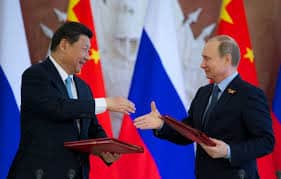
Good work Mr. President! You have now managed to lay the groundwork for a grand Chinese-Russian alliance. The objective of intelligent diplomacy is to divide one’s foes, not to unite them.
This epic blunder comes at a time when the US appears to be getting ready for overt military action in Syria against Russian and Syrian forces operating there. The excuse, as before, will be false-flag attacks with chlorine gas, a chemical widely used in the region for water purification. It appears that the fake attacks have already been filmed.
Meanwhile, some 303,000 Russian, Chinese and Mongolian soldiers are engaged in massive maneuvers in eastern Siberia and naval exercises in the Sea of Japan and Sea of Okhotsk. The latter, an isolated region of Arctic water, is the bastion of Russia’s Pacific Fleet of nuclear-armed missile submarines.
Interestingly, President Vladimir Putin, who has attended the war games with his Chinese counterpart, Xi Jinping, just offered to end the state of war between Russia and Japan that has continued since 1945. He also offered some sort of deal to resolve the very complex problem of the Russian-occupied Kuril Islands (Northern Territories to Japan) that has bedeviled Moscow–Tokyo relations since the war. The barren Kurils control the exits and entry to the Sea of Okhotsk where Russia’s nuclear missiles shelter.
In the current war games, Russia has deployed 30,000 military vehicles and 1,000 combat aircraft. China contributed 3,200 troops, 30 warplanes and naval units. Most of the equipment deployed in Vostok-18 was state of the art. Russia’s and China’s infantry, artillery and armor appeared impressive and combat ready – or as we in the US Army used to say, ‘STRAC.’
Why were these huge exercises being held in remotest eastern Siberia? First, so China could contribute forces close to its territory. Second, as a possible warning to the United States not to invade North Korea, which is just to the south and abuts on both China and Russia. Third, as a demonstration of the improved effectiveness of Russia and China’s military and as a warning to the US and its NATO satraps not to pick a fight with Russia over Ukraine, Syria or the Black Sea.
On a grander scale, Beijing and Moscow were signaling their new ‘entente cordiale’ designed to counter-balance the reckless military ambitions of the Trump administration, which has been rumbling about a wider war in Syria and intervention in, of all places, Venezuela. The feeling in Russia and China is that the Trump White House is drunk with power and unable to understand the consequences of its military actions, a fact underlined by recent alarming exposés about it.
Russia and China appear – at least for now – to have overcome their historic mutual suspicion and animosity. In the over-heated imagination of many Russians, China often appears to be the modern incarnation of the Mongol hordes of the past that held ancient Rus in feudal thrall. Russians still call China ‘Kitai’, or Cathay.
For the Chinese, Russia is the menacing power that stole large parts of eastern Siberia in the 19th century. Today, Russia frets that China’s 1.4 billion people will one day swamp the Russian Far East which has only 6.2 million inhabitants spread over a vast, largely empty region which is one of the world’s least inhabited.
In the 1960’s, after the Soviet Union and China became ideological antagonists, the two sides frequently clashed along their border rivers, Amur and Ussuri. They almost stumbled into a full-scale war on their 4,000 km border– at a time when the US had invaded Vietnam supposedly to ‘halt Chinese-Soviet aggression.’ The CIA was as ill-informed back then as it is today.
Vladimir Putin and Xi Jinping attended the grand display, along with their senior military staffs. This week-long martial event, Russia’s largest war games in almost four decades, overshadowed the smaller military exercise being staged by NATO in Ukraine.
The message from eastern Siberia was clear: Washington’s reckless hostility and bellicosity is causing its foes to band together. A full third of the Russian Army just moved from Europe to the Far East for the war games. The Chinese dragon of which Napoleon warned is awakening.
Reprinted with permission from EricMargolis.com.

